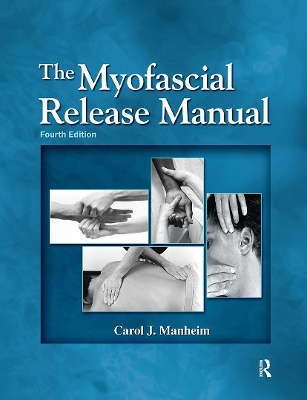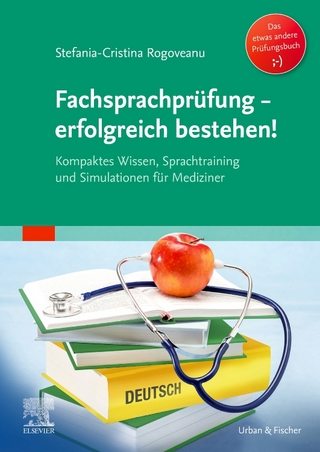
The Myofascial Release Manual
SLACK Incorporated (Verlag)
978-1-55642-835-7 (ISBN)
Continuing the tradition that started over 20 years ago and with a new focus on the current terminology regarding each technique, The Myofascial Release Manual is now available in a completely updated and comprehensive Fourth Edition.
Carol J. Manheim has taken years of knowledge and expertise and incorporated them with the actual intent and result of the myofascial release treatment techniques to bring to the pages of this Fourth Edition essential information for the student and clinician in search of basic information or wanting to refine more experienced skills of these manual therapy techniques.
Features inside the Fourth Edition:
-Techniques re-titled to reflect the sensation felt by both the therapist and the patient -More than 75 new photographs—Over 450 in total -Some photographs are shown as a series to allow for movement to be seen during some techniques -Bolded text to call attention to major warnings, contraindications, and target vital information -Italicized text to call attention to important words and key points -More synthesized use of text and photographs to allow for ease of reading and reference -User-friendly organization throughout the text -Photographs use arrows to show direction of stretch and movement -“Carol’s Nuggets” of pearls of wisdom are included throughout the text -Contributions from renowned experts Sam Kegerreis, Robert O. Ward, and Steven Nowicki
The Myofascial Release Manual, Fourth Edition continues in the tradition of past editions and presents expert hand placement for the upper quarter, lower quarter, cervical region, abdominal muscles, back muscles, and many more.
Sections include:
-Introduction to Myofascial Release -Basic Myofascial Release Techniques -Advanced Myofascial Release Techniques -Evaluation -Additional Resources
The description and photographs in The Myofascial Release Manual, Fourth Edition help the therapist experience the technique, making this the continued go-to reference for students and clinicians in physical therapy, manual therapy, and occupational therapy alike.
Carol J. Manheim, MS, MEd, PT, LPC, received her MS degree from Case Western Reserve University and her MEd in clinical counseling from The Citadel. Ms. Manheim is a physical therapist and licensed professional counselor in private practice in Charleston, South Carolina.
Contents Dedication Acknowledgments About the Author Preface Section I: Introduction to Myofascial Release Introduction to Myofascial Release Myofascial Therapy Sam Kegerreis, MS, PT, ATC Biomedical and Infomedical Models Pathological Distinctions Structural Concepts Tensegrity Myofascial Restrictions Anatomy of Fascia Soft Tissue Injuries and Myofascial Pain Tightness and Restriction Conceptual Models Fascia as a Balloon Fascia as Plastic Wrap Fascia and Muscle as Red Elastic Bands Myofascial Release: A Brief History Robert C.Ward, DO Understanding Myofascial Release Trust Feelings Basic Principles Assumptions Process of Change Learning Myofascial Release Basic Steps: An Overview of Treatment Onion Metaphor Gross Release of Any Muscle Focused Release of Any Muscle Gross Versus Focused Release Sensation of a Release Autonomic Response to a Release Response to Myofascial Release End-Feel Psychological Effects of Myofascial Release and Other Manual Therapies Essence of Myofascial Release Special Considerations Enigma of the /u201cGood Hurt/u201d Boundaries Significance of Touch and Nonverbal Communication Steven Nowicki, PhD Focusing on Feedback: Communication Exercises Exercise 1. Communicating Emotions Touch As Communication Exercise 2. Personal Space Protocols for Myofascial Release Indications Contraindications Precautions Pre-Treatment Protocols Establishing the Therapeutic Environment Testing for Vascular Integrity Post-Treatment Protocols Drink... Drink... Drink Be Kind to Your Hands Section II: Basic Myofascial Release Techniques Upper Quarter Release Release of the Shoulder Rotators A Learning Exercise: Focusing on Feedback Sidelying Release of the Parascapular Muscles Lower Quarter Release Sidelying Release of the Gluteal Muscles Trapezius Bilateral Release of the Upper Trapezii Unilateral Release of the Upper Tr apezius Focused Release of the Upper Trapezius Release of the Splenius Capitis and Semispinalis Capitis Bilateral Release of the Middle Trapezii Unilateral Release of the Middle Trapezius Focused Release of the Middle Trapezius Release of the Lower Trapezius Focused Release of the Lower Trapezius Cervical Region Release of the Posterior Cervical Musculature Cranial Base Release Gross Release of the Sternocleidomastoid Focused Release of the Sternocleidomastoid Gross Release of the Scalp Muscles: Hair Release Gross Release of the Face Muscles: Ear Release Gross and Focused Release of the Scalp and Face Muscles Release of the Hyoids Pectoralis Major and Minor Release of the Horizontal Fibers of the Pectoralis Major Release of the Diagonal Fibers of the Pectoralis Major Release of the Pectoralis Minor Intercostals and the Rib Cage Gross and Focused Release of the Intercostal Muscles Release of the Rib Cage Gross Release of the Quadratus Lumborum Abdominal Muscles Gross Release of the Rectus Abdominis Gross Release of the Abdominal Obliques Gross Release of the Tranversus Abdominis Iliopsoas Gross Release of the Iliopsoas Focused Release of the Iliacus Pectineus Focused Release of the Pectineus Piriformis Focused Release of the Piriformis Lower Extremity Muscles Gross Release of the Quadriceps Femoris Gross Release of the Sartorius Gross and Focused Release of the Tensor Fascia Lata Gross and Vertical Gross Release of the Hamstrings Gross Release of the Anterior Tibialis Focused Release of the Peroneus Longus Gross Release of the Soft Tissue of the Forefoot and Toes Gross and Focused Release of the Plantar Fascia Gross and Focused Release of the Gastrocnemius Gross Release of the Soleus Gross Release of Both Legs and the Lower Trunk Back Muscles Gross Release of the Levator Scapula Gross Release of the Rhomboids Focused Release of the Supraspinatus Focused Release of the Infraspinatus Gross and Focused Release of the Teres Major and Minor Gross Release of the Subscapularis Gross and Focused Release of the Erector Spinae Sidelying Gross Release of the Quadratus Lumborum Sidelying Gross Release of the Latissimus Dorsi Sidelying Gross Release of the Iliocostalis Lumborum Upper Extremity Muscles Gross Release of the Deltoids Gross and Focused Release of the Biceps Brachii Gross and Focused Release of the Brachialis Gross and Focused Release of the Brachioradialis Gross Release of the Wrist and Finger Extensors Gross Release of the Extensor Carpi Radialis Focused Release of the Extensor Carpi Ulnaris Gross Release of the Pronator Teres Focused Release of the Wrist and Finger Flexors Focused Release of the Flexor Carpi Radialis Focused Release of the Flexor Carpi Ulnaris Focused Release of the Adductor Pollicis Focused Release of the flexor Pollicis Brevis Focused Release of the Interosseus Gross Release of the Abductor Digiti Minimi Gross Release of the Soft Tissue of Each Finger Gross Release of the Triceps Focused Release of the Triceps Gross Release of Both Arms and the Upper Trunk Section III: Advanced Myofascial Release Techniques Anterior Chest Wall Release Thoracic Fascia Release Diaphragm Release Pelvic Floor Release Sacral Fascia Release Myofascial Trigger Points Trigger Point Release Tender Points Tender Point Release Skin and Scar Restrictions Evaluating Skin and Scar Mobility Skin Roll Release /u201cJ/u201d Stroke Release Scars Indirect Gross Scar Release Direct Gross Scar Release Vertical Direct Gross Scar Release Direct Scar Skin Roll Release Indirect Scar Skin Roll Release Direct Focused Scar Release Myofascial Strum Release Long Stroke Strum Release Short Stroke Strum Release Dural Tube Dysfunction Testing for Dural Tube Dysfunction Criteria for Performing a Dural Tube Release Dural Tube Anatomy Metaphor Dural Tube Release Combination Releases Treatment in Three Dimensions Section IV: Evaluation: Initial Assessment General Considerations Initial Interview Posture Evaluation Pain Assessment Headaches Section V: Additional Resources Posture Evaluation Standing—Facing Forward Standing—Facing Right Standing—Facing Left Standing—Facing Backward Sitting—Front View Sitting—Right View Sitting—Left View Sitting—Back View Supine—Observation and Palpation Prone—Observation and Palpation References Additional References Index
| Erscheint lt. Verlag | 30.8.2008 |
|---|---|
| Sprache | englisch |
| Maße | 216 x 279 mm |
| Gewicht | 1097 g |
| Themenwelt | Medizin / Pharmazie ► Medizinische Fachgebiete |
| ISBN-10 | 1-55642-835-9 / 1556428359 |
| ISBN-13 | 978-1-55642-835-7 / 9781556428357 |
| Zustand | Neuware |
| Informationen gemäß Produktsicherheitsverordnung (GPSR) | |
| Haben Sie eine Frage zum Produkt? |
aus dem Bereich


